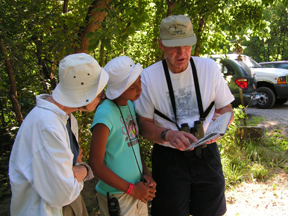
birding adventure in Logan Canyon
Courtesy Stephen Peterson
Hi, I’m Holly Strand from Stokes Nature Center in beautiful Logan Canyon.
According to Chris Leahy, in his encyclopedic book, Birdwatcher’s Companion, birdwatching refers to “the regular, somewhat methodical seeking out and observation of birds, whether for pure aesthetic pleasure or recreation, or for a more serious, quasi-scientific motive.“
If you are in America, the term birdwatcher is most often applied to people with a passing interest in birds, perhaps as backyard bird aficionados. In contrast, birders are people who seek out birds “in a more serious and energetic manner, either to hone field-identification skills, or to amass an impressive life list.” A life list is simply a record of all the species of birds that one has seen during his or her life. An impressive list in North America may consist of 6 00-700 birds. A person who travels to see birds may have a list of 4000+ .
The demographics of birders are interesting. A 2001 study estimates that there are 46 million birders or birdwatchers 16 years of age or older in the US. Within this collective group, the average person is 49 years old , has a better than average income and education, and is more likely to be female, white and married. Among Utah residents , 27 % of the population qualify as birdwatchers. Utah ranks 18 among states according to % of residents who watch birds. Montana is first at 44%, followed by Vermont at 43%.
However, 88% of the birders considered by this study were categorized as casual or backyard birdwatchers. If you consider only avid birders with carefully-honed identification skills and people who keep life lists, the gender balance shifts dramatically. That’s why most sources consider birding a strongly male –dominated activity. In fact, birdwatching has been described to be an expression of the male hunting instinct as well as linked with the male tendency for “systemizing” which has to do with organizing, categorizing, listing and counting.
A subset of the avid birder group is formed by twitchers. A twitcher is devoted to ticking off as many birds as possible for his or her lifelist. I am told that in the UK twitchers will appear suddenly as a ‘flock’ in some remote corner of the country (or someone’s backyard) whenever a very rare bird has been spotted—usually a migrant blowing in from Europe or North America. Twitchers use the latest in communication media –hotlines, mailing lists, eforums, bulletin-boards, and web-based databases to find out when a rare bird is in the vicinity. Then they will use whatever means available –perhaps a helicopter!—to get there as fast possible. Here in Utah, a twitcher might use the hotline on Utahbirds.org as one source of information.
Those of you who associate with birders will probably agree that they are as fascinating as the birds themselves. Here’s to you, my avian-loving friends.
Thanks to the Rocky Mountain Power Foundation for supporting research and development of Wild About Utah topics.
For Wild About Utah and Stokes Nature Center, I’m Holly Strand.
Credits:
Photo: Courtesy Stephen Peterson, Bridgerland Audubon Society
Text: Stokes Nature Center: Holly Strand
Sources & Additional Reading:
Leahy, Christopher. 1982. The Birdwatcher’s Companion. An Encyclopedic Handbook of North American Birdlife. NY: Grammercy Books.
Maddox, Bruno. 2006. Blinded By Science Birding Brains: How birding in Central Park in an age of terror makes the man. Discover. Science, Technology and the Future. published online November 30, 2006 (https://discovermagazine.com/2006/dec/blinded-twins-birding-instinct accessed February 14, 2009)
Pullis, La Rouche, G. 2003. Birding in the United States: a demographic and economic analysis. Addendum to the 2001 National Survey of Fishing, Hunting and Wildlife-Associated Recreation. Report 2001-1. US Fish and Wildlife Service. Arlington, VA.
